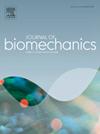行走时使用足部矫形器对成人扁平足患者下肢关节角度和力矩的影响:系统综述与 Meta 分析
IF 2.4
3区 医学
Q3 BIOPHYSICS
引用次数: 0
摘要
本系统性综述和荟萃分析旨在研究应用足部矫形器(FO)对患有灵活扁平足的成年人在行走过程中下肢关节角度和力矩的影响。从开始到 2024 年 3 月,系统检索了以下五个数据库:Scopus、PubMed、EMBASE、PEDro 和 Cochrane 对照试验中央注册中心 (CENTRAL)。采用随机效应模型计算组间标准化均值差异(SMD)及 95% 置信区间。研究异质性采用 I2 指数进行评估。共确定了 24 项研究并进行了元分析。然后根据应用的扁平足评估方法对研究进行了分类:(1)足姿指数(FPI-6)或临床观察;(2)足印足弓指数或放射学检查;(3)足弓高度指数(包括舟状突下降、足弓高度指数、舟状突高度与足长归一化[NNHT]);(4)前足外翻法;(5)后足外翻或静止小腿站立位(RCSP)。荟萃分析表明,行走时应用 FO 对后足外翻峰值(10 项研究:中等 SMD)、踝关节外翻峰值(5 项研究:小 SMD)和外翻(7 项研究:中等 SMD)有显著影响。这项荟萃分析表明,应用 FO 对踝关节外翻峰值力矩(5 项研究:小 SMD)和膝关节内收峰值力矩(6 项研究:小 SMD)有显著效果。在使用 FPI-6 方法评估足部姿势的研究中,我们观察到应用 FO 对步行力学的影响更大。由于之前的研究表明,FPI-6 方法的测试-再测试可靠性特别高,因此我们建议在未来的研究中统一使用这种脚部姿势测量方法。本文章由计算机程序翻译,如有差异,请以英文原文为准。
Effects of foot orthoses application during walking on lower limb joint angles and moments in adults with flat Feet: A systematic review with Meta-Analysis
This systematic review with meta-analysis aimed to investigate the effects of foot orthoses (FO) application on lower limb joint angles and moments in adults with flexible flat-feet during walking. The following five databases were systematically searched from inception until March 2024: Scopus, PubMed, EMBASE, PEDro, and Cochrane Central Register of Controlled Trials (CENTRAL). Between-group standardized mean differences (SMDs) with 95% confidence intervals were computed using a random-effects model. Study heterogeneity was assessed using the I2-index. Twenty-four studies were identified and meta-analyzed. Studies were then categorized according to the applied flat-feet assessment method: (1) foot posture index (FPI-6) or clinical observation; (2) foot print arch index or radiography; (3) arch height index (including navicular drop, the arch height index, navicular height normalized to foot length [NNHT]); (4) forefoot varus method; (5) rearfoot eversion or resting calcaneal stance position (RCSP). The meta-analysis showed significant effects of FO application during walking on peak rearfoot eversion (ten studies: moderate SMDs), peak ankle dorsiflexion (five studies: small SMDs), and eversion (seven studies: moderate SMDs). This meta-analysis indicated significant effects of FO application on peak ankle eversion moment (five studies: small SMDs) and peak knee adduction moment (six studies: small SMDs). We observed greater effects of FO application on walking mechanics in the studies that used the FPI-6 method for the assessment of foot posture. Since previous research showed particularly high test–retest reliability measures for the FPI-6 method, we recommend to uniformly use this type of foot posture measure in future studies.
求助全文
通过发布文献求助,成功后即可免费获取论文全文。
去求助
来源期刊

Journal of biomechanics
生物-工程:生物医学
CiteScore
5.10
自引率
4.20%
发文量
345
审稿时长
1 months
期刊介绍:
The Journal of Biomechanics publishes reports of original and substantial findings using the principles of mechanics to explore biological problems. Analytical, as well as experimental papers may be submitted, and the journal accepts original articles, surveys and perspective articles (usually by Editorial invitation only), book reviews and letters to the Editor. The criteria for acceptance of manuscripts include excellence, novelty, significance, clarity, conciseness and interest to the readership.
Papers published in the journal may cover a wide range of topics in biomechanics, including, but not limited to:
-Fundamental Topics - Biomechanics of the musculoskeletal, cardiovascular, and respiratory systems, mechanics of hard and soft tissues, biofluid mechanics, mechanics of prostheses and implant-tissue interfaces, mechanics of cells.
-Cardiovascular and Respiratory Biomechanics - Mechanics of blood-flow, air-flow, mechanics of the soft tissues, flow-tissue or flow-prosthesis interactions.
-Cell Biomechanics - Biomechanic analyses of cells, membranes and sub-cellular structures; the relationship of the mechanical environment to cell and tissue response.
-Dental Biomechanics - Design and analysis of dental tissues and prostheses, mechanics of chewing.
-Functional Tissue Engineering - The role of biomechanical factors in engineered tissue replacements and regenerative medicine.
-Injury Biomechanics - Mechanics of impact and trauma, dynamics of man-machine interaction.
-Molecular Biomechanics - Mechanical analyses of biomolecules.
-Orthopedic Biomechanics - Mechanics of fracture and fracture fixation, mechanics of implants and implant fixation, mechanics of bones and joints, wear of natural and artificial joints.
-Rehabilitation Biomechanics - Analyses of gait, mechanics of prosthetics and orthotics.
-Sports Biomechanics - Mechanical analyses of sports performance.
 求助内容:
求助内容: 应助结果提醒方式:
应助结果提醒方式:


